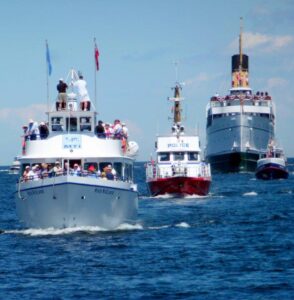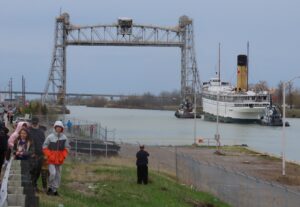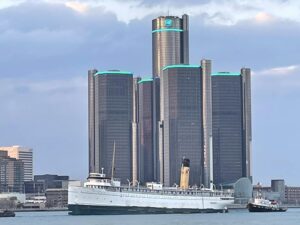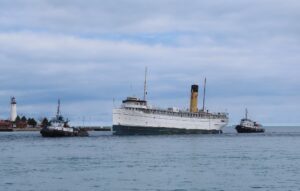Around the World
Keewatin On The Move – The Kee’s Final Voyage
Jun 2023 | By Pat Brennan
 The first time the S.S. Keewatin went through the Welland Canal, it had to be cut in three pieces in Sorel, Quebec. At 106 metres in length, it was too long for the canal’s original locks, and disassembly was the only way forward. It was stitched back together in Buffalo, and continued on to Port McNicoll to become the principal connection between Southern Ontario and Western Canada for nearly 60 years.
The first time the S.S. Keewatin went through the Welland Canal, it had to be cut in three pieces in Sorel, Quebec. At 106 metres in length, it was too long for the canal’s original locks, and disassembly was the only way forward. It was stitched back together in Buffalo, and continued on to Port McNicoll to become the principal connection between Southern Ontario and Western Canada for nearly 60 years.
As soon as Georgian Bay was free of ice this April, Keewatin – called The Kee by its fans – departed its home in Port McNicoll to make the trek back to the Welland Canal to drop anchor at Kingston’s Maritime Museum of the Great Lakes. Over the past 11 years, it has tried unsuccessfully to be a floating museum since landing back in Port McNicoll on June 12, 2012 – exactly 46 years to the hour since it left the port on its last voyage to Thunder Bay. Unfortunately, there’s not enough tourism traffic through the region to sustain Keewatin as a museum, and so Keewatin’s fate has changed once more.
 Five years older than the Titanic, The Kee is the largest of the very few remaining Edwardian passenger steamships in the world. When it was being built in 1906 at the Fairfield Shipbuilding and Engineering Company in Glasgow, Scotland, it was alongside countless other steamers in a boom of steamship travel. Now, it alone remains the sole Canadian vessel of its age; an important relic of our Maritime history.
Five years older than the Titanic, The Kee is the largest of the very few remaining Edwardian passenger steamships in the world. When it was being built in 1906 at the Fairfield Shipbuilding and Engineering Company in Glasgow, Scotland, it was alongside countless other steamers in a boom of steamship travel. Now, it alone remains the sole Canadian vessel of its age; an important relic of our Maritime history.
After its last trip in 1967 to Thunder Bay – then known as Port Arthur and Fort William – CP Railway planned to scrap Keewatin. Before the order could be given however, Michigan entrepreneur R.J. Petersen saved it from the cutting torches, purchasing the vessel and moving it to Saugatuck Harbour near Chicago as a floating museum. Years later, at age 86, Petersen wanted to see The Keewatin returned to Canada before his death, fearing that his sons would convert its steel hull into razor blades and car bumpers.
 Thunder Bay wanted to buy the historic vessel as part of its plan to make its industrial waterfront more of a people place. Outbidding the Lakehead, Toronto developer Gil Blutrick, then president of Skyline Developments, had The Keewatin instead towed 960 kilometres by tugboats from Michigan back to Port McNicoll to become a community centre for a proposed waterfront development of 2,500 recreational homes. Only a dozen homes were built at the site before Skyline sold the property and donated The Kee to the Kingston museum as a tax write-off.
Thunder Bay wanted to buy the historic vessel as part of its plan to make its industrial waterfront more of a people place. Outbidding the Lakehead, Toronto developer Gil Blutrick, then president of Skyline Developments, had The Keewatin instead towed 960 kilometres by tugboats from Michigan back to Port McNicoll to become a community centre for a proposed waterfront development of 2,500 recreational homes. Only a dozen homes were built at the site before Skyline sold the property and donated The Kee to the Kingston museum as a tax write-off.
There’s a dry dock beside the waterfront museum in Kingston which, for many years, was occupied by the retired Canadian Coast Guard icebreaker Alexander Henry. The icebreaker was operated for many years as a B&B until it was discovered that it contained a high volume of asbestos insulation and was not fit for habitation. The Kingston museum site was sold for a future high-rise condominium, but as the project never came to fruition, it remains the Maritime Museum.
The Alexander Henry was going to be scrapped with the museum sale, but Thunder Bay entrepreneurs raised enough money to tow the icebreaker to the Lakehead as they had originally attempted with Keewatin prior to its purchase by Skyline Developments. This fortuitous conclusion gives both ships a dignified end, and benefits both cities by incorporating them into community spaces.
 Fans of the Keewatin will be able to photograph this sleek vessel on its historic voyage as she slips through a narrow channel to pass under the Blue Water Bridge in Sarnia. All along this voyage, crowds will gather to capture the historic final chapter of the beloved steamer.
Fans of the Keewatin will be able to photograph this sleek vessel on its historic voyage as she slips through a narrow channel to pass under the Blue Water Bridge in Sarnia. All along this voyage, crowds will gather to capture the historic final chapter of the beloved steamer.
 Photographers stood in Dieppe Gardens on the Windsor Riverfront to catch The Kee passing by the renowned Detroit skyline, many fans rented a room at The Inn At Lock Seven where all the balconies overlook the Welland Canal, and enthusiasts gathered along the elevated viewing platform at Lock 3, where people often watch ships travel along the Niagara Escarpment. Before leaving the canal, Keewatin pulled into the Port Weller Dry Dock for a much-needed facelift that will take several months to complete. At the same time, shipwrights at Port Weller will do maintenance work to make sure The Kee is seaworthy for the remainder of its cruise.
Photographers stood in Dieppe Gardens on the Windsor Riverfront to catch The Kee passing by the renowned Detroit skyline, many fans rented a room at The Inn At Lock Seven where all the balconies overlook the Welland Canal, and enthusiasts gathered along the elevated viewing platform at Lock 3, where people often watch ships travel along the Niagara Escarpment. Before leaving the canal, Keewatin pulled into the Port Weller Dry Dock for a much-needed facelift that will take several months to complete. At the same time, shipwrights at Port Weller will do maintenance work to make sure The Kee is seaworthy for the remainder of its cruise.
After Port Weller, The Kee will head across Lake Ontario to enter the western gap at Toronto Harbour where the William Lyon Mackenzie – Toronto’s fire boat – will escort her with its powerful water cannons gushing out a salute. Keewatin will leave the harbour via the eastern gap and carry on to Kingston.
 Eric Conroy, a long-time Keewatin volunteer who had been a teenage waiter in the ship’s dining room during its active service, is organizing the transfer. His involvement is a poetic end to the journey of The Kee, bringing its story full circle back to its many long years of service. This final voyage is a fitting farewell for Canada’s last Edwardian steamer, ending the era of Titanic-age passenger vessels.
Eric Conroy, a long-time Keewatin volunteer who had been a teenage waiter in the ship’s dining room during its active service, is organizing the transfer. His involvement is a poetic end to the journey of The Kee, bringing its story full circle back to its many long years of service. This final voyage is a fitting farewell for Canada’s last Edwardian steamer, ending the era of Titanic-age passenger vessels.

